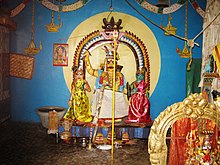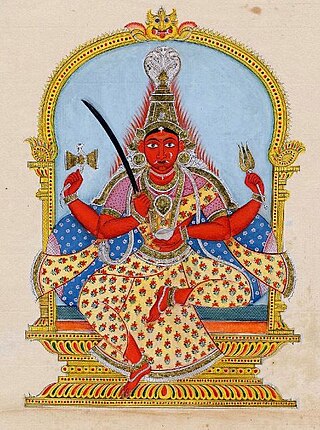
Mariamman, often abbreviated to Amman, is a Hindu goddess of weather, predominantly venerated in the rural areas of South India. Her festivals are held during the late summer/early autumn season of Ādi throughout Tamil Nadu and the Deccan region, the largest being the Ādi Thiruviḻa. Her worship mainly focuses on bringing rains and curing diseases like cholera, smallpox, and chicken pox. Mariamman is worshipped in accordance with local traditions such as Pidari or the Gramadevatai. She is considered as a guardian deity by many South Indian village-dwellers.
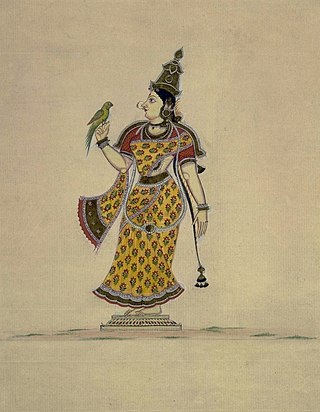
Meenakshi is a Hindu goddess. She is the tutelary deity of Madurai and is considered an avatar of the goddess Parvati. She is the divine consort of Sundareśvarar, a form of Shiva. She finds mention in literature as the queen of the ancient Madurai-based Pandya kingdom, and is later deified. The goddess is also extolled by Adi Shankara as Shri Vidya.
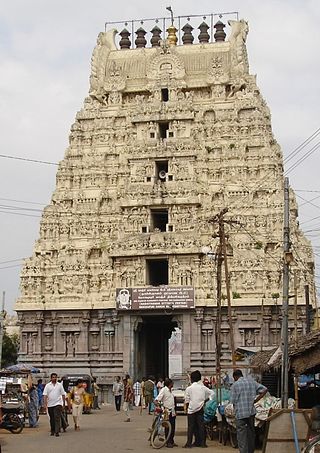
The Sri Kamakshi Amman Temple is an ancient Hindu Temple dedicated to the goddess Kamakshi, one of the highest aspects of Adi Parashakti, the mighty goddess in Shaktism. The temple is located in the historic city of Kanchipuram, near Chennai, India. The temple houses one of the 108 Divya Desams of Vishnu and is called Tirukalavanur. The temple is dedicated mainly to Kamakshi and then to Vishnu in his form of Varaha. The temple is glorified by the 6th-9th century Vaishnavite Alvars in the Naalayira Divya Prabandham. Its construction is credited to the Pallava kings, whose capital was in the same city. This temple, along with the goddesses of Madurai and either Varanasi or Thiruvanaikovil, are the important centers of Shaktism in the state of Tamil Nadu. The present temple is also known as Kamakoti Peetha or Kamakota Nayaki Kovil, where Tripura Sundari had settled after killing a demon. This ancient temple was mentioned in Perunaraatrupadai, an ancient Tamil literature that praises the renowned Sangam era. King Thondaiman Ilandiraiyan of the Pallava dynasty, who ruled Kanchipuram, constructed the temple. Kamakshi is worshipped in the shrine in 5 forms, one of them was a golden idol, which was transported to Thanjavur due to the Muslim invasions of Kanchipuram. There are no other goddess temples in the city of Kanchipuram, apart from this one, which is unusual in a city that has hundreds of traditional temples. There are various legends that account for this fact.

The Nellaiappar Temple is a Hindu temple dedicated to the deity Shiva, located in Tirunelveli, a city in the South Indian state of Tamil Nadu. Shiva is worshipped as Nellaiappar represented by the lingam and his consort Parvati is depicted as Kanthimathi Amman. The deity Vishnu is also worshipped here, having witnessed their wedding according to legend. Hence, this temple is regarded as an abhimana kshetram of Vaishnavism. The temple is located on the northern banks of Thamirabarani River in Tirunelveli district. The presiding deity is revered in the 7th century Tamil Saiva canonical work, the Tevaram, written by Tamil saint poets known as the nayanmars and classified as Paadal Petra Sthalam.

Arulmigu Meenakshi Sundaraswarar Temple a.k.a Arulmigu Meenakshi Amman Thirukkovil is a historic Hindu temple located on the southern bank of the Vaigai River in the temple city of Madurai, Tamil Nadu, India. It is dedicated to the goddess Meenakshi, a form of Shakti, and her consort, Sundareshwarar, a form of Shiva. The temple is at the centre of the ancient temple city of Madurai mentioned in the Tamil Sangam literature, with the goddess temple mentioned in 6th-century CE texts. This temple is one of the Paadal Petra Sthalams, which are 275 temples of Shiva that are revered in the verses of Tamil Saiva Nayanars of the 6th-9th century CE.

The Srivilliputhur Andal Temple in Srivilliputhur, a town in Virudhunagar district in the South Indian state of Tamil Nadu, is dedicated to the Hindu god Vishnu. It is located 80 km from Madurai. Constructed in the Dravidian style of architecture, the temple is glorified in the Nalayira Divya Prabandham, the early medieval Tamil canon of the Alvar saints from the 6th–9th centuries CE. It is one of the 108 Divya Desams dedicated to Vishnu, who is worshipped as Vatapatrasayi and his consort Lakshmi as Andal. It is believed to be the birthplace of two of the Alvars, namely Periyalvar and his foster-daughter, Andal.

The village deities of Southern India are the numerous spirits and other beings venerated as part of the Dravidian folk tradition in villages throughout South India. These deities, mainly goddesses, are intimately associated with the well-being of the village, and can have either benevolent or violent tendencies. These deities are presently in various stages of syncretism or assimilation with mainstream Hindu traditions.
Sacchidananda Bharati I , was a Hindu sant and religious leader of the 17th century. He was the Jagadguru of the Hindu matha Sringeri Sharada Peetham from 1623 to 1663, and is believed to have saved it from attack by spiritual means.

The Mutharamman Temple is located in Kulasekharapatnam near Thiruchendur in the Thoothukudi district, Tamil Nadu. It is 300 years old. The temple is situated at a distance of 14 km. from Tiruchendur.
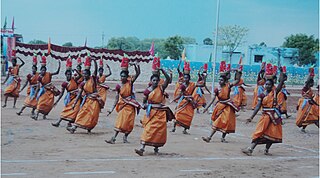
Karakaattam, or Karagam Puja in the Caribbean, is an ancient folk dance of Tamil Nadu performed in praise of the rain goddess Mariamman. The ancient Tamil epic says that this type of dance derived from Bharatham and a mixture of multiple forms of Tamil dance forms like Bharatanatyam postures and mudras. The offering of this dance is to the goddess to bless rain. The dance accompanies songs like folk Carnatic (Amrithavarshini).
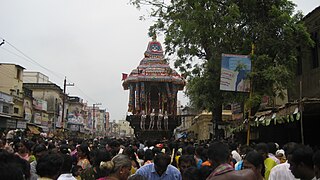
Chithirai Festival, also known as Chithirai Thiruvizha, Meenakshi Kalyanam or Meenakshi Thirukalyanam, is an annual Tamil Hindu celebration in the city of Madurai during the month of April. The festival, celebrated during the Tamil month of Chithirai, is associated with the Meenakshi Temple, dedicated to the goddess Meenakshi, a form of Parvati and her consort Sundareshwar, a form of Shiva.
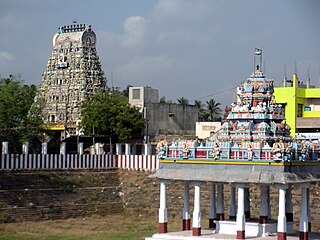
Thyagaraja Temple is a Hindu temple dedicated to Hindu god Shiva. It is located in Tiruvottiyur in the northern part of Chennai, Tamil Nadu, India. The temple is revered by the Tevaram hymns of Saiva nayanars, the 7th century Tamil saint poets and classified as Paadal Petra Sthalam. All the Three of Thevaram Moovar has rendered Thevaram songs in this temple. The temple is closely associated with the saint poet Sundarar and Pattinathar. The temple has been in vogue from the Pallava times of the 7th century and widely expanded by Chola kings during the 11th century. The temple has a seven tiered gateway tower, a tank, with the overall temple area covering 1 acre. The temple is administered by the Hindu Religious and Endowment Board of the Government of Tamil Nadu. The temple draws parallel with the Thygaraja temple in Tiruvarur as both the temples were expanded by Rajendra Chola I and both have the same dance poses of Shiva. The temple is one of the 51 Sakthi Peetams in the country.

Madurai Veeran (transl. The Warrior of Madurai) is a 1956 Indian Tamil-language action film directed by D. Yoganand, written by Kannadasan, and produced by Lena Chettiar. Based on the folklore legend turned deity of the same name, it stars M. G. Ramachandran as the eponymous character, with P. Bhanumathi and Padmini playing his love interests. T. S. Balaiah, N. S. Krishnan and T. A. Mathuram play supporting roles.
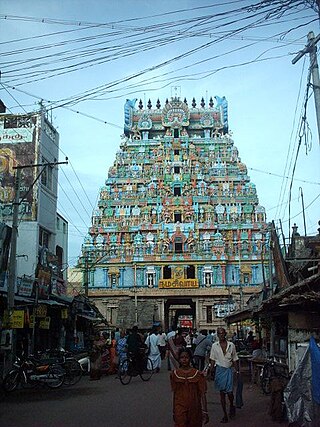
Thiruvanaikaval Paadal Petra Sthalam (திருவனைகோவில்) or Thiruvanaikovil is a neighbourhood in the city of Tiruchirappalli in Tamil Nadu, India. It is situated on the northern banks of the Kaveri river, on the Srirangam Island.
Madurapuram is a small village in India that lies on the banks of the Vaigai River and on the National Highway 49 that connects Madurai with Rameshwaram. The village is situated 18 kilometres (11 mi) from Madurai. Though Madapuram is near Madurai it is within Sivagangai district. The famous Madurapuram Badhrakali amman and ayyanar temple is situated at this place. Today this temple is managed by HR & CE ministry of Government of Tamil Nadu.

Vandiyur Mariamman Teppakulam is a temple tank located near to Vandiyur Mariamman Temple and situated at a distance of about 5 km from the Meenakshi Amman Temple. Literally, Teppakulam means temple pond mainly used for devotional festivals.
Nilakantha Diksita was a minister in the 17th century court of King Thirumalai Nayak of Madurai. He composed several poems and literary works, including Ananda Sagara Stavam.
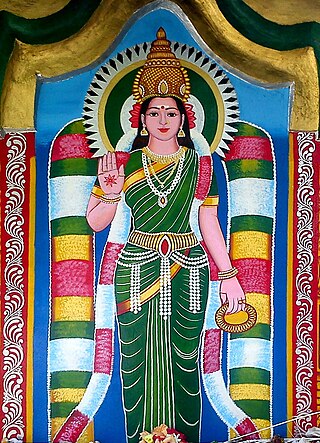
Kannaki Amman is the deified form of Kannagi, the heroine of the Tamil epic Cilappatikāram. She is worshipped in parts of Sri Lanka, Tamil Nadu, and Kerala. As a goddess of chastity, she is venerated by Indian Tamils and Malayalis, Sri Lankan Tamil Shaivites, and also by the Sinhalese Buddhists as Pattini Amma. In regional Hindu tradition, her tale is interpreted as the story of Durga demanding justice after the death of her husband, Kovalan, who is identified as a form of Shiva.

Sri Ramalinga Sowdeshwari Amman, commonly abbreviated to Sowdeshwari, is a Hindu folk deity, regarded by adherents to be a regional form of either Mahadevi or Parvati. She is considered to be the Kuladevata of the Devanga people.
Meenakshi Sundaresvarar Temple is a Hindu temple dedicated to the deity Shiva located at Arimalam of Pudukkottai district in Tamil Nadu, India.
